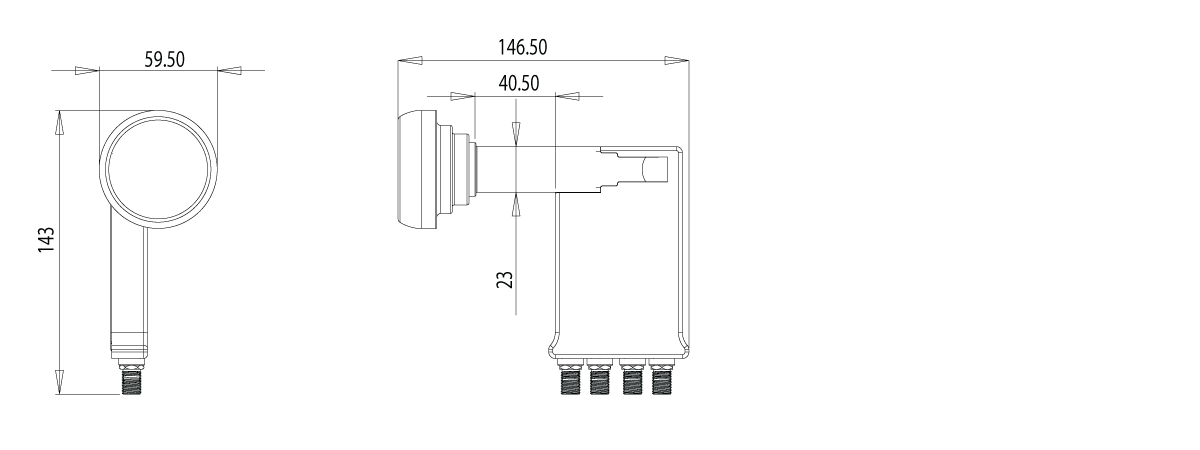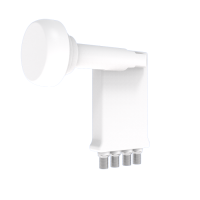The ASTRA2Connect service makes broadband Internet access available to homes in rural locations or otherwise beyond the reach of existing terrestrial broadband services. This special Quad-LNB makes Broadband and TV both possible for ASTRA2Connect subscribers with one satellite dish. The standard ASTRA2Connect equipment consists of a single feed iLNB for internet and TV / radio services from 23.5° E. Mounted on the Multifeed Clamp, Inverto’s special Quad-LNB enhances the ASTRA2Connect experience with an extensive choice of TV and radio channels via the ASTRA satellites. The upgrade gives consumers additional access to more than 1,150 TV and radio channels at 19.2°E or more than 460 channels at 28.2°E. The new LNB is suitable for directly connecting up to four digital or analogue satellite receivers. It uses a special filter to suppress disturbances caused by the simultaneous use of internet and TV reception via satellite.
Main Features:
- 14GHz filter for optimal TV and Radio reception
- Low phase Noise HDTV-DVBS2 compliant
- Low Noise Figure (Max. 0.7 dB)
- Low Power consumption
- High Cross-Pole performance
- High Frequency stability
| Technical specifications | |
|---|---|
| Low band input frequency range | 10.7 GHz ~ 11.7 GHz |
| Low band output frequency range | 950 MHz~ 1950 MHz |
| Low band LO frequency |
9.75 GHz |
| High band input frequency range |
11.7 GHz ~ 12.75 GHz |
| High band output frequency range | 1100 MHz ~ 2150 MHz |
| High band LO frequency |
10.6 GHz |
| Noise figure |
0.7 dB typ. (1.0 dB max.) |
| LO temperature drift | ±3.0 MHz max. |
| LO initial accuracy | ±1.0 MHz max. |
| LO phase noise @ 10 kHz |
-80 dBc / Hz max. |
| Conversion gain |
56 dB min. |
| Gain ripple (over 26 MHz bandwidth) | ±0.75 dB |
| Gain variation (over full band) | ±5 dB max. |
| Image rejection |
40 dB min. |
| 1 dB compression point (@ output) | 0.0 dBm min. |
| Cross polarization isolation | 22 dB min. |
| Control signal Ca (V) |
11.5 V ~ 14.0 V |
| Control signal Cb (H) |
16.0 V ~ 19.0 V |
| Control signal Cc (band switching) |
22 ±4 kHz |
| Output VSWR |
2.0 : 1 |
| In band spurious level | -60 dBm max. |
| Current consumption |
200 mA max. @ 11 V ~ 20 V |
| Operating temperature |
-30 °C ~ +60 °C |
| Output impedance |
75 Ω |
| Output connector type |
F-Type (female) |
| Weight | 255 g |
| Logistical info | |
| Packaging dimensions (W x D x H) | 14,9 cm x 6,3 cm x 14,9 cm |
| Packaging weight | 0,33 kg |
| Quantity per Carton | 24 pcs |
| Carton dimensions (W x D x H) | 38.2 cm x 33.6 cm x 31.8 cm |
| Carton weight | 9,0 kg |
| Quantity per pallet | 432 pcs |


Images

Drawings

FAQ
Q: What is an LNB?
A:
An LNB - Low Noise Block (also called an LNC- Low Noise Converter), it is used for communications (broadcast) satellite reception. The LNB is usually affixed either in or on the satellite dish and its purpose is to collect and amplify the satellite signal received from the dish and then down convert the signal to lower more manageable IF frequency which can then be carried over standard coaxial cabling to the receiver.
Q: What is a feedhorn?
A:
The feedhorn is a part of the LNB and works like a directional horn. Its function is to capture the signals reflected from the dish and to shield the LNB from receiving extraneous radiation from other sources. These collected signals are then passed form the horn to the electronics within the LNB.
Q: What is the difference between a Quad and Quattro LNB?
A:
A quad or quad switch LNB is an LNB where the multi switch is integrated into the LNB and gives 4 independent output ports for the connection of 4 receivers. A Quattro LNB has 4 outputs and each of the output’s is set to one of the differing polarities, the 4 outputs are V/L, V/H, H/L & H/H. A Quattro LNB is normally used to feed a multiswitch which then allows the distribution of the signal to any number of satellite receivers. All four outputs of a Quattro LNB are marked accordingly with V/L, V/H, H/L & H/H to avoid confusion and malfunctions when connecting to the multiswitch.
Q: What is the HsQuare Technology?
A:
HsQuare is a unique waveguide technology which may be coupled with a slightly larger feed horn design to deliver better RF performances compared with common circular microwave waveguides.
Q: What is a monoblock LNB?
A:
This design consists of two independent LNBs in a single housing and allows a user the potential of receiving the signal from two different satellites which are at slightly different orbital opposition from a single dish installation. The switching between the satellitesis achieved via the use of DiSEqC signals or Toneburst (Mini DiSEqC). Monoblock LNB’s are available mostly for satellites with a fixed 4.3° or 6° spacing and the range covers Ku band monoblock switch single, twin and quad outputs.
Example where a 6° monoblock LNB could be used is for the reception of ASTRA 1 (19.2° East) and Hotbird (13° East) or with 4.3° distance for the reception of ASTRA 1 (19.2° East) and ASTRA 3 (23.5° East).
Q: Why can I receive only one satellite with my monoblock LNB?
A:
For dual satellite reception the dish is normally initially aligned to the weaker of the two satellites and then some slight adjustment can be made ensure the best possible reception from both the satellites. A monoblock installation will require a slightly larger dish size than if only one satellite location had been chosen. Monoblock LNBs are designed to work on a specific dish size and it’s important that the correct dish size is installed or both satellites signals may not be picked up at a sufficient level of strength to guarantee reliable reception.
Q: What is a wideband LNB?
A:
With a wideband LNB having only one local oscillator (e.g. 10.4GHz), and captures the full frequency spectrum of the satellite (300MHz to 2350MHz) which are delivered over two outputs from the LNB. One output carries all the vertically polarized signals whilst the second output carries all the horizontally polarized outputs. Whilst most of the current multiswitches on the market do not accept a wideband input the newer multiswitches such as newer Unicable switches are capable of accepting this as their input.
Caution: Wideband LNBs are not conventional twin LNBs. Wideband LNBs can be connected to a Unicable multiswitches that is designed for this purpose, or, if connected directly to a receiver, only with a suitable tuner.
Q: What does Unicable mean?
A:
Unicable is a new method for distributing satellite television. Several receivers (currently up to 32 in accordance with standard EN 50607) can be connected to only one single chain which is not possible with a conventional satellite distribution (star distribution in multi-switch mode). For more information about Unicable, see www.inverto.tv/what-is-unicable-2


